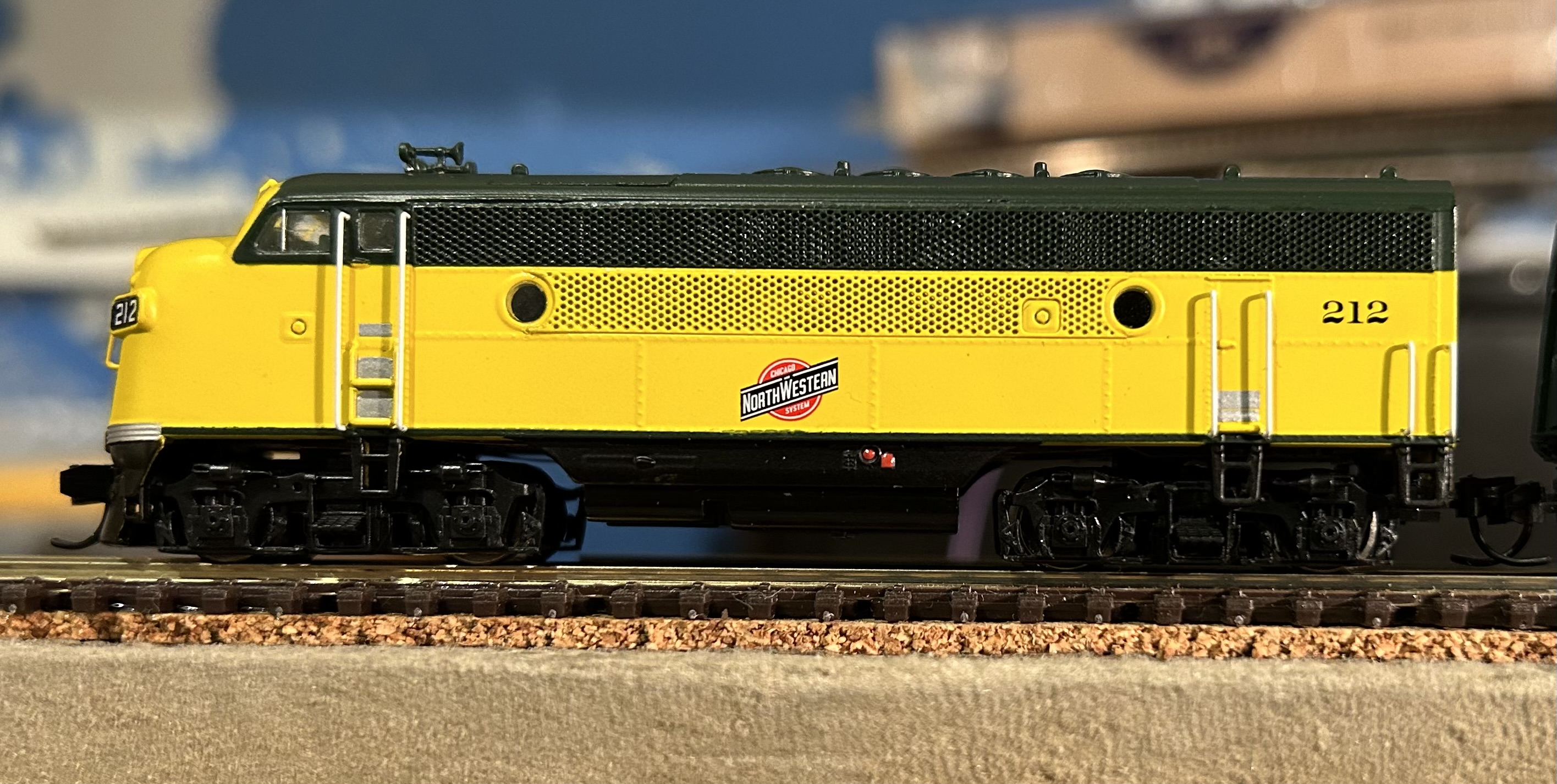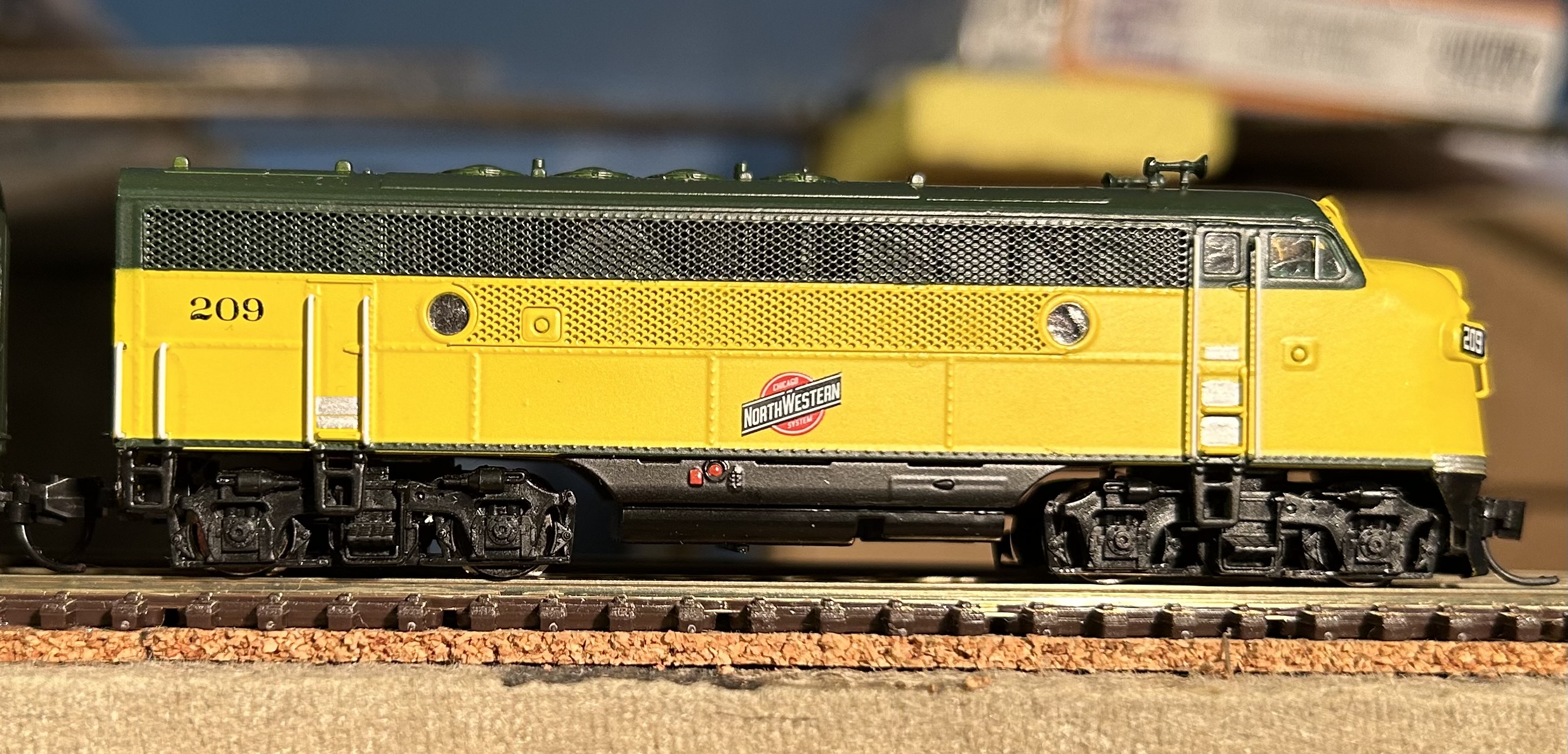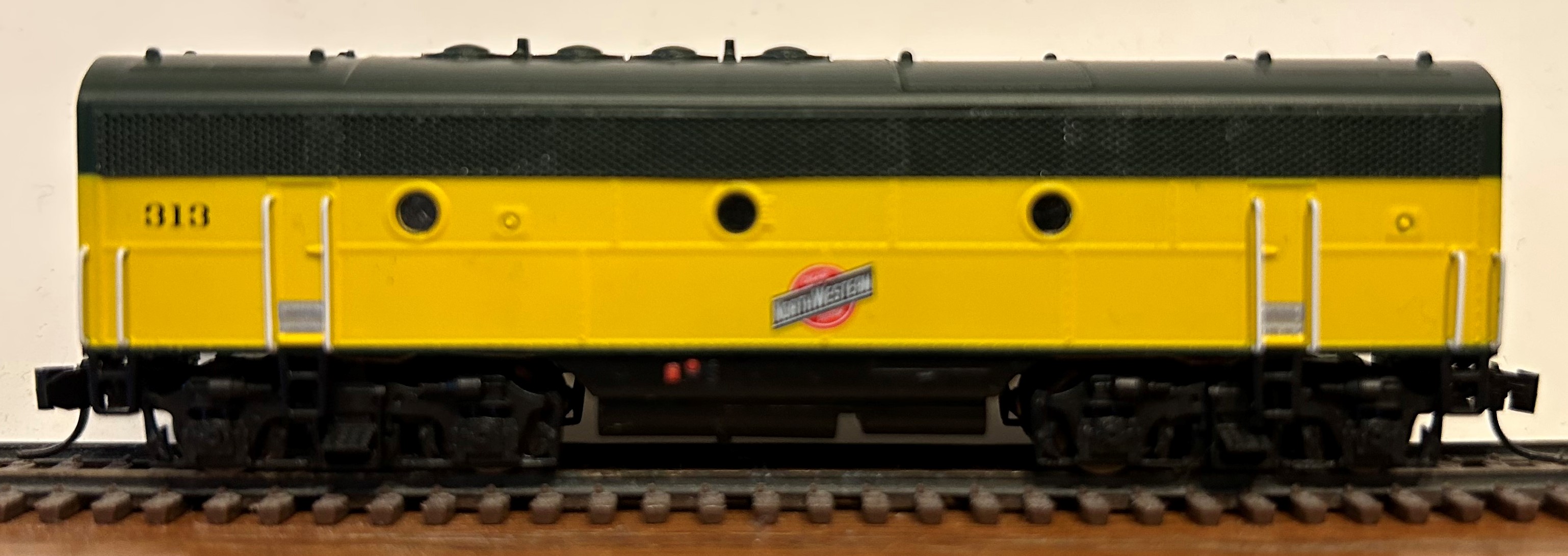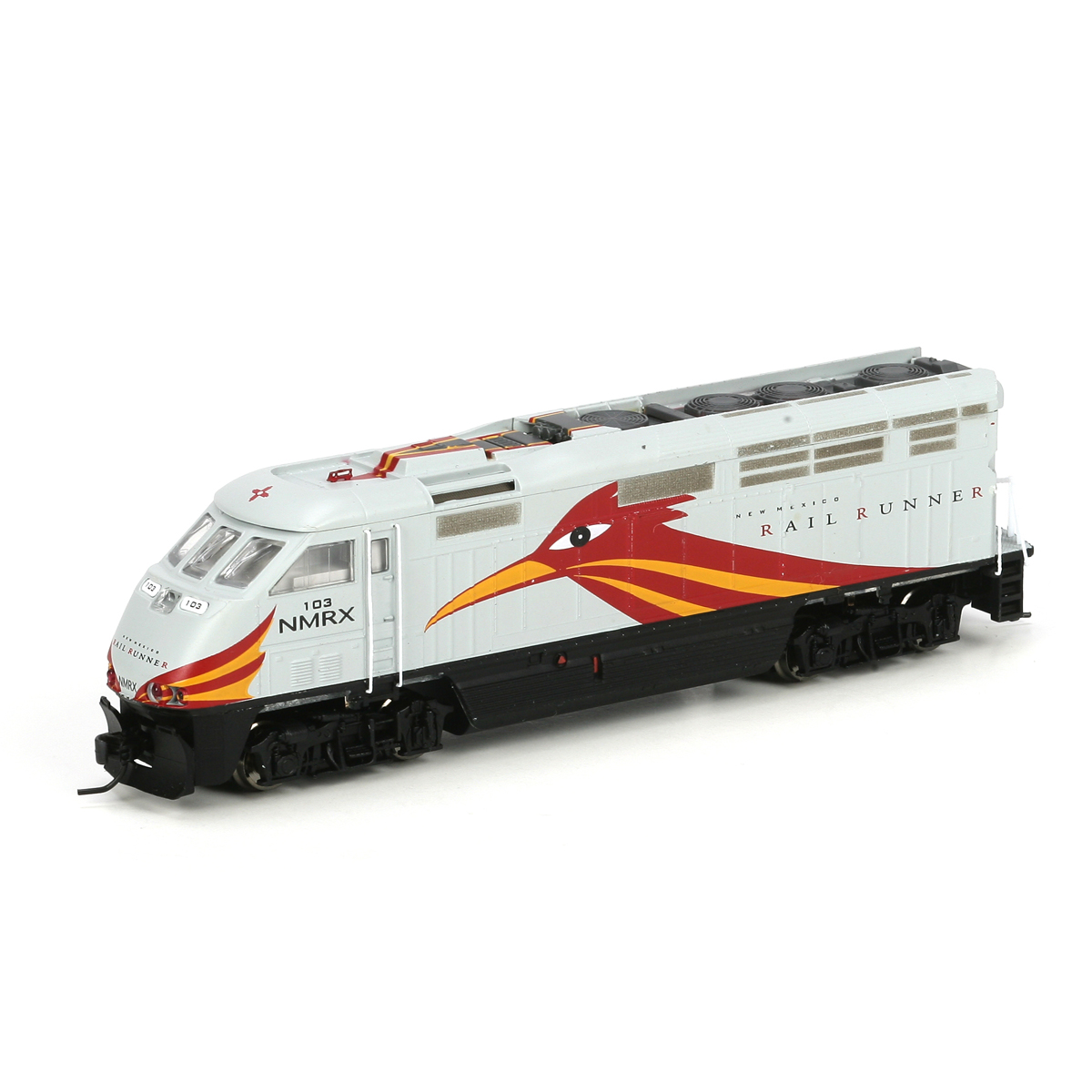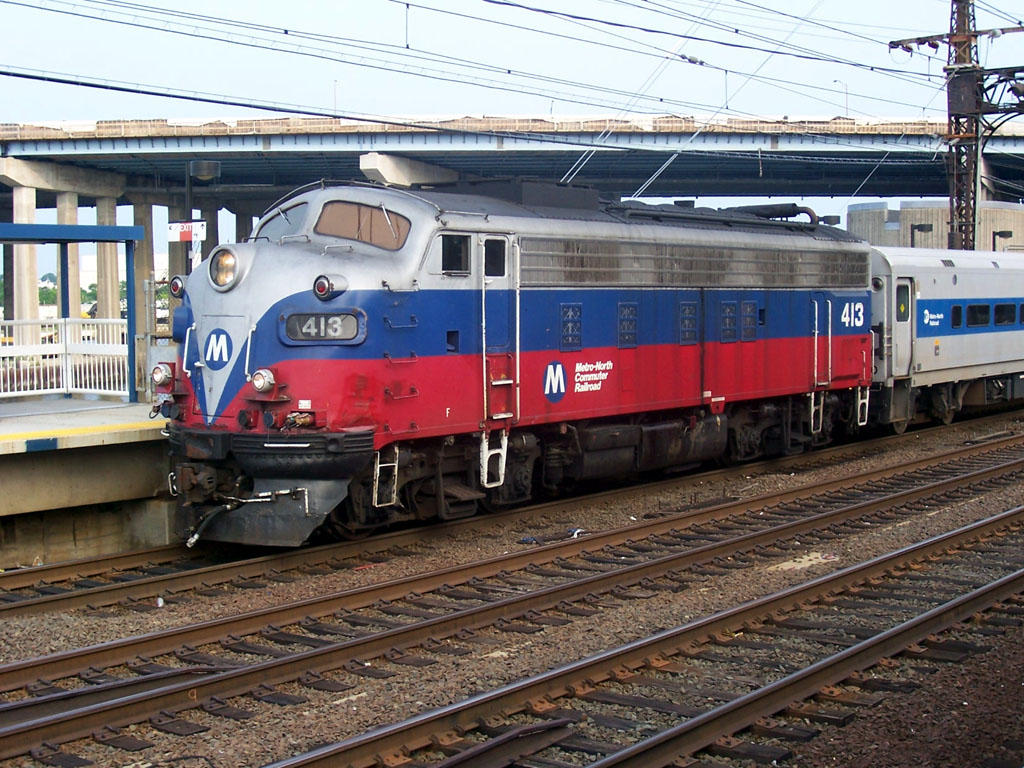Model Information: InterMountain introduced this model in 2005, and have since followed up with several subsequent runs. The model shares the same chassis as Intermountain's F7s. The PC board was re-designed in 2014 with motor contact "shoes" replaced by wires.
In December 2014, a new run of several road numbers was announced which introduced new factory DCC-equipped versions, sound and non-sound. These models come with a brand new design that incurred significant delays. First batch is expected to be delivered mid-2017.
These locos sport all of the niceties one normally associates with "modern" diesel models, e.g. - split-frame DCC-Ready metal chassis, dual-flywheels, low-friction drive, plastic truck assemblies, plastic gearing, blackened wheels, all-wheel drive / pick-up (no traction tires). The motor is an open-sided 5-poler. Directional lighting on A units is controlled by a PC board mounted on top of the chassis, and with the LED headlight mounted on the front of the chassis (with wires running between the two).
In December 2014, a new run of several road numbers was announced which introduced new factory DCC-equipped versions, sound and non-sound. These models come with a brand new design that incurred significant delays. First batch is expected to be delivered mid-2017.
These locos sport all of the niceties one normally associates with "modern" diesel models, e.g. - split-frame DCC-Ready metal chassis, dual-flywheels, low-friction drive, plastic truck assemblies, plastic gearing, blackened wheels, all-wheel drive / pick-up (no traction tires). The motor is an open-sided 5-poler. Directional lighting on A units is controlled by a PC board mounted on top of the chassis, and with the LED headlight mounted on the front of the chassis (with wires running between the two).
DCC Information:
Models released up to 2014: These locos are qualified as "DCC-Friendly" and not "Ready" because installing after-market decoders requires de-soldering and re-soldering a few wires. Not too complex, but you'll need a soldering iron...
- For locos released before 2014: front light of A units needs to be re-soldered to the decoder board.
- For locos released after 2014: in addition to the front light, the motor contacts are performed by two wires that need to be re-soldered to the decoder board.
Accepts the following decoders (non-sound):
- Digitrax DN163I1C: 1.5 Amp N Scale Mobile Decoder for Intermountain F3 / F7 Units. (discontinued)
- Digitrax DN166I1C: 1.5 Amp Decoder for Intermountain N scale F3 and F7 A & B units with motor contact "shoes".
- Digitrax DN166I1D: 1.5 Amp Decoder for InterMountain N Scale F7A & B units with wired motors produced after Jan 2014.
- TCS IMF4: 4 Function Decoder for Intermountain F3A/B, F7A/B and F9B N-Scale locomotives. (Installation for Intermountain F3A)
- TCS IMF4-NF: 4 Function Decoder for Intermountain F3A/B, F7A/B and F9B N-Scale locomotives produced after Jan 2014. (Installation for Intermountain F7A)
Models released as of 2017: this model is proposed factory-equipped with either a non-sound DCC decoder (models suffixed by "D") or a sound DCC decoder (models suffixed by "S"), both from ESU - LokSound Select Micro or LokPilot Micro.
Models released up to 2014: These locos are qualified as "DCC-Friendly" and not "Ready" because installing after-market decoders requires de-soldering and re-soldering a few wires. Not too complex, but you'll need a soldering iron...
- For locos released before 2014: front light of A units needs to be re-soldered to the decoder board.
- For locos released after 2014: in addition to the front light, the motor contacts are performed by two wires that need to be re-soldered to the decoder board.
Accepts the following decoders (non-sound):
- Digitrax DN163I1C: 1.5 Amp N Scale Mobile Decoder for Intermountain F3 / F7 Units. (discontinued)
- Digitrax DN166I1C: 1.5 Amp Decoder for Intermountain N scale F3 and F7 A & B units with motor contact "shoes".
- Digitrax DN166I1D: 1.5 Amp Decoder for InterMountain N Scale F7A & B units with wired motors produced after Jan 2014.
- TCS IMF4: 4 Function Decoder for Intermountain F3A/B, F7A/B and F9B N-Scale locomotives. (Installation for Intermountain F3A)
- TCS IMF4-NF: 4 Function Decoder for Intermountain F3A/B, F7A/B and F9B N-Scale locomotives produced after Jan 2014. (Installation for Intermountain F7A)
Models released as of 2017: this model is proposed factory-equipped with either a non-sound DCC decoder (models suffixed by "D") or a sound DCC decoder (models suffixed by "S"), both from ESU - LokSound Select Micro or LokPilot Micro.
Prototype History: The EMD F3 was a 1,500-horsepower (1,100 kW) B-B freight- and passenger-hauling diesel locomotive produced between July 1945 and February 1949 by General Motors’ Electro-Motive Division. Final assembly was at GM-EMD's La Grange, Illinois plant. A total of 1,111 cab-equipped lead A units and 696 cabless booster B units were built.
The F3 was the third model in GM-EMD's highly successful F-unit series of cab unit diesel locomotives, and it was the second most produced of the series. The F3 essentially differed from the EMD F2 in that it used the “new” D12 generator to produce more power, and from the later EMD F7 in electrical equipment. Some late-model F3's had the same D27 traction motors, along with the heavier-duty electrical cables, used in the F7, and were referred to as model F5 by EMD's Engineering Department.
From Wikipedia
Read more on American-Rails.com
The F3 was the third model in GM-EMD's highly successful F-unit series of cab unit diesel locomotives, and it was the second most produced of the series. The F3 essentially differed from the EMD F2 in that it used the “new” D12 generator to produce more power, and from the later EMD F7 in electrical equipment. Some late-model F3's had the same D27 traction motors, along with the heavier-duty electrical cables, used in the F7, and were referred to as model F5 by EMD's Engineering Department.
From Wikipedia
Read more on American-Rails.com
Road Name History: The Chicago and North Western Transportation Company (reporting mark CNW) was a Class I railroad in the Midwestern United States. It was also known as the North Western. The railroad operated more than 5,000 miles (8,000 km) of track as of the turn of the 20th century, and over 12,000 miles (19,000 km) of track in seven states before retrenchment in the late 1970s.
Until 1972, when the company was sold to its employees, it was named the Chicago and North Western Railway. The C&NW became one of the longest railroads in the United States as a result of mergers with other railroads, such as the Chicago Great Western Railway, Minneapolis and St. Louis Railway and others.
By 1995, track sales and abandonment had reduced the total mileage back to about 5,000. The majority of the abandoned and sold lines were lightly trafficked branches in Iowa, Illinois, Minnesota, South Dakota and Wisconsin. Large line sales, such as those that resulted in the Dakota, Minnesota and Eastern Railroad further helped reduce the railroad to a mainline core with several regional feeders and branches.
The company was purchased by Union Pacific Railroad (UP) in April 1995 and ceased to exist.
Until 1972, when the company was sold to its employees, it was named the Chicago and North Western Railway. The C&NW became one of the longest railroads in the United States as a result of mergers with other railroads, such as the Chicago Great Western Railway, Minneapolis and St. Louis Railway and others.
By 1995, track sales and abandonment had reduced the total mileage back to about 5,000. The majority of the abandoned and sold lines were lightly trafficked branches in Iowa, Illinois, Minnesota, South Dakota and Wisconsin. Large line sales, such as those that resulted in the Dakota, Minnesota and Eastern Railroad further helped reduce the railroad to a mainline core with several regional feeders and branches.
The company was purchased by Union Pacific Railroad (UP) in April 1995 and ceased to exist.
Brand/Importer Information: InterMountain was founded in 1985 by Fred Brummet. They got started in the model railroad business by producing O-Scale model kits. They got started in the N Scale business almost a decade later when in 1994 they introduced the 40-23 reefer car in kit form. Later, in 1998, they started producing RTR (Ready-to-Run) models. By the early 2000s, InterMountain phased out kit production in favor of the RTR models.
The InterMountain Railway company is located at 1224 Boston Ave in Longmont, CO. They are a manufacturer of HO, N and Z scale model trains. They have produced kits as well as RTR (Ready-To-Run) models. Their N Scale products include locomotives as well as rolling stock. Their rolling stock lineup includes Boxcars, Hoppers, Tank Cars, Reefers, Gondolas, Stock Cars and Flatcars.
Their locomotive releases have primarily been diesel units, with the one major exception being their series of AC-12 Cab Forward steam locos. Their diesel lineup includes F3's, F7's, F9's, SD40's, SD45's and FT units. They are known for quality and detail. They also release their rolling stock in larger varieties of road numbers than most of the other manufacturers.
The InterMountain Railway company is located at 1224 Boston Ave in Longmont, CO. They are a manufacturer of HO, N and Z scale model trains. They have produced kits as well as RTR (Ready-To-Run) models. Their N Scale products include locomotives as well as rolling stock. Their rolling stock lineup includes Boxcars, Hoppers, Tank Cars, Reefers, Gondolas, Stock Cars and Flatcars.
Their locomotive releases have primarily been diesel units, with the one major exception being their series of AC-12 Cab Forward steam locos. Their diesel lineup includes F3's, F7's, F9's, SD40's, SD45's and FT units. They are known for quality and detail. They also release their rolling stock in larger varieties of road numbers than most of the other manufacturers.
Item created by: dennis.kamper on 2023-12-13 11:02:24. Last edited by dennis.kamper on 2023-12-22 11:43:53
If you see errors or missing data in this entry, please feel free to log in and edit it. Anyone with a Gmail account can log in instantly.
If you see errors or missing data in this entry, please feel free to log in and edit it. Anyone with a Gmail account can log in instantly.


